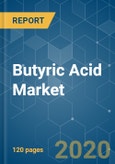The market for butyric acid is expected to register a CAGR of greater than 5% globally during the forecast period.
Key Market Trends
Increasing Demand from the Pharmaceutical Sector
Butyric acid has been increasingly used as an intermediate in the manufactuer of chemicals as well as pharmaceuticals . Apart from that, butyric acid finds its application in perfumes, animal feed, food, and flavors.
Asia-Pacific Region to Dominate the Market
Asia-Pacific is expected to dominate the global market, owing to the highly developed healthcare sector in China, coupled with the continuous investments done in the region to advance the food processing and chemical sector through the years.
Competitive Landscape
The butyric acid market is partially consolidated in nature with a few major players dominating a significant portion of the market. Some of the major companies are Eastman Chemical Company, Oxea GmbH, Perstorp Holding AB, Tokyo Chemical Industry Co. Ltd, and Merck KGaA.
Reasons to Purchase this report:
- Rising number of food processing industries and increasing the usage of butyric acid as intermediate are driving the market growth.
- Fluctuating raw materials and associated health hazards are expected to hinder the market growth.
Key Market Trends
Increasing Demand from the Pharmaceutical Sector
Butyric acid has been increasingly used as an intermediate in the manufactuer of chemicals as well as pharmaceuticals . Apart from that, butyric acid finds its application in perfumes, animal feed, food, and flavors.
- Butyric acid has been gaining popularity among the consumers as an ingredient for compounds that aid in weight reduction and also helping people to fight cancer.
- Irritable bowel syndrome (IBS) is a very common disorder that affects digestion. After carrying out various kinds of of research, researchers conclude that butyrate supplementation seems to be a promising therapy for IBS.
- Rising number of people with obesity, growing anxiety problems, increasing prevalence of chronic diseases, aalong with favorable healthcare policies in developed regions are driving the expansion of and adoption of newer formulations in recent times. Such factors are expected to drive the market for butyric acid through the years to come.
Asia-Pacific Region to Dominate the Market
Asia-Pacific is expected to dominate the global market, owing to the highly developed healthcare sector in China, coupled with the continuous investments done in the region to advance the food processing and chemical sector through the years.
- Moreover, butyric acid has been using in food to improve food flavor and increase the taste of food. Recently, there is rapid growth in the food processing industries in China and Korea and in the Asia-Pacific region.
- Butyric acid consumption for animals has been significantly rising. It helps in maintaining animal intestinal health and growth performance, especially in young and vulnerable animals.
- According to the IQVIA Institute for Human Data Science, the Chinese pharmaceutical sector has shown the highest growth rates over previous years. According to the American Chemistry Council, Butyric acid demand in the chemical industry in the Asia-Pacific region is highest around the world and has been growing gradually.
- Increasing demand for animal feed, presence of butyric acid in advanced medical treatments and components, continuous growth in the chemical and paint industries are expected to drive the market for butyric acid through the years to come.
Competitive Landscape
The butyric acid market is partially consolidated in nature with a few major players dominating a significant portion of the market. Some of the major companies are Eastman Chemical Company, Oxea GmbH, Perstorp Holding AB, Tokyo Chemical Industry Co. Ltd, and Merck KGaA.
Reasons to Purchase this report:
- The market estimate (ME) sheet in Excel format
- 3 months of analyst support
Table of Contents
1 INTRODUCTION
4 MARKET DYNAMICS
5 MARKET SEGMENTATION
6 COMPETITIVE LANDSCAPE
7 MARKET OPPORTUNITIES AND FUTURE TRENDS
Companies Mentioned (Partial List)
A selection of companies mentioned in this report includes, but is not limited to:
- Beijing Huamaoyuan Fragrance Flavor Co. Ltd
- Blue Marble Biomaterials
- Eastman Chemical Company
- Merck KGaA
- Oxea GmbH
- Perstorp Holding AB
- Shanghai Kayi Chemical Co. Ltd
- Snowco Industrial Co. Ltd
- Thermo Fisher Scientific
- Tokyo Chemical Industry Co. Ltd
Methodology

LOADING...








